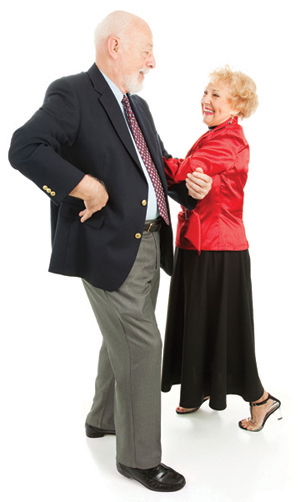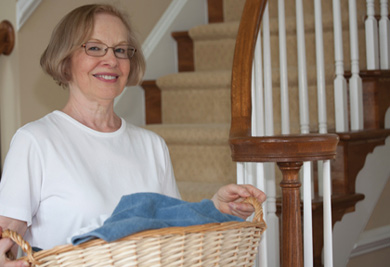Too Fit to Fracture, Part 3
Balance challenges keep you on your feet
By: Lora Giangregorio, PhD
After the age of 40, we lose 0.5% to 1% of the bone mass in our skeleton each year. A diagnosis of osteoporosis means that bones have weakened to the point where they could break from a simple fall.
Osteoporosis affects about 1.4 million Canadians. One in three women and one in five men over the age of 50 will have a fracture due to osteoporosis at some point, often caused by a fall. Fractures can lead to other health problems and loss of function, or independence.
Building balance to prevent falls and fractures
About one in three older adults who still live in their own homes report at least one fall in the past year. Exercises that challenge balance have been shown to prevent falls. Incorporate things that challenge your balance into your daily life or exercise routine. For instance, during your daily walk, switch to some unusual walking patterns, such as alternating between brisk stepping, long strides, and side-stepping.
Walk heel to toe – like on an imaginary tightrope – on the way back from the rest room. Do step-ups, one leg at a time onto a high step. Dancing offers good balance challenges too. Give yourself enough of a challenge that you have to work to stay on your feet, while taking precautions to reduce your risk of falling. Wear appropriate footwear, and progress the challenges slowly.
You can do balance challenges while watching TV or waiting for the microwave. In fact, forward, backward or side lunges are a good way to both build strength in your legs and challenge your balance at the same time. Clock Yourself is a new app designed by a physical therapist to provide balance challenges in 3 minutes per day. It introduces progressively more complex activities to train you to think on our feet and to react quickly.

It takes time to make new exercise habits. Pick one new exercise habit. Plan when you are going to do it. Write it down. When you master it, add a new one. The small habits you create now can prevent falls and broken bones later.
About the Author
Dr. Lora Giangregorio is an Associate Professor of Kinesiology at the University of Waterloo. She is also the Schlegel Research Chair in Mobility and Aging. Her research program focuses on strategies to reduce the risk of fracture, and increase physical activity and mobility in older adults. Lora translates her research into practice by working with government and non-profit organizations and linking with community-based programs. She collaborated with Osteoporosis Canada to develop the Too Fit to Fracture exercise recommendations.
Click Here for print PDF file – Active Living Too Fit to Fracture 3
Sweeping away the house-cleaning blues
by Sandra J. Hartley, M.P.E., Ed.D.
One thing you can count on at home is dust. It settles. Dirt tracks in. “Stuff” collects. The mess just returns week after week. I envy people who do not care about dust bunnies, floor crumbs, and clutter. Yet I feel out of sorts when the place isn’t tidy.
Keeping a place clean week after week seems to be an exercise in futility… or is it? Research suggests we should view regular domestic activity as a health and longevity advantage. Couch potatoes who settle into hours of television are missing out by not taking advantage of physical activity in the home.
Decades of research support the health benefits of regular, moderate physical activity. Health Canada even notes improved wellness for those who simply “spending less time sitting.” Surely housework is going to get some brownie points here.
Can housework be part of a fitness routine?
Can housework and gardening count as exercise? You bet. The good you get depends on how long and how much effort you give. The added benefit of “housercise” is that your place looks great and it doesn’t cost you a fitness membership!
In 1997, O’Brien Cousins published an illustrated guide to kitchen warm-up and home workout ideas, just using the features of your home. Any non-stop physical activity creates warmth, and that burns calories. You can ramp up the pace of housework if you want to get more exercise out of it, and get it done faster.
The strength and endurance needed for house work does add up and contributes to an active healthy life.
Add up your effort:
Health benefits come with time and intensity of effort. Intensity of effort is measured in Metabolic Equivalent Units or MET units. These units are rough estimates of the energy spent by an average person weighing 60 kilos. For instance, a 60 kilo sitting adult will burn about l kilocalorie per kilogram per minute. This is a MET unit of 1.0. If you weigh more than 60 kilos, your MET estimate adjusts slightly up. If you weigh less than 60 kilos, your estimate adjusts slightly down.
Mild activities like slow walking or moving around the house dusting double the effort of sitting. These activities have an effort close to a MET unit of 2.0. Just as brisk walking brings you into deeper breathing (3-5 METS), so does brisk vacuuming or lawn mowing. Housecleaning rarely competes with the intensity of jogging (6-8 Mets) or hard running (9-10 METS). Still, sweaty housework, scrubbing walls and windows, and moving furniture, at 5 METS x 60 minutes adds up to about 300 kilocalories spent! Compare that to your gym workout.
Just one activity, say 30 minutes of vacuuming, or cutting the lawn, uses about 100 kilocalories of your energy each week. If you do that 52 times a year, that is almost a pound of fat. Add in all the sweeping, scrubbing, carrying groceries, wiping, dusting, folding, and so on, and you can see that hiring a house cleaner might NOT be the best decision for your health.

People who move live longer
Everyday lifestyle habits add up over the years. In the 1950s, researchers studied the heart health of British bus drivers compared to ticket takers on London’s double decker buses. This all-male study showed longevity differences based on occupational activity. Drivers, who sat all day, fared poorly for heart disease compared to ticket takers, who moved around the stairwells collecting tickets.
The active things you choose to do everyday DO matter. Things like walking the dog and cycling to work are healthy choices. But you may be choosing to be more active simply by living in a walk-ups apartment or multi-floored townhouse.
So jump out of bed, chase those dust bunnies, push that vacuum, pound dough for homemade bread, carry home your groceries, and sweep away the house cleaning blues.
About the Author
Sandra J. Hartley is a Professor Emeritus with the Faculty of Physical Education and Recreation, University of Alberta.
Click Here for print PDF file – Active Living – sweeping away the house cleaning blues

- Categories
Recent Posts

